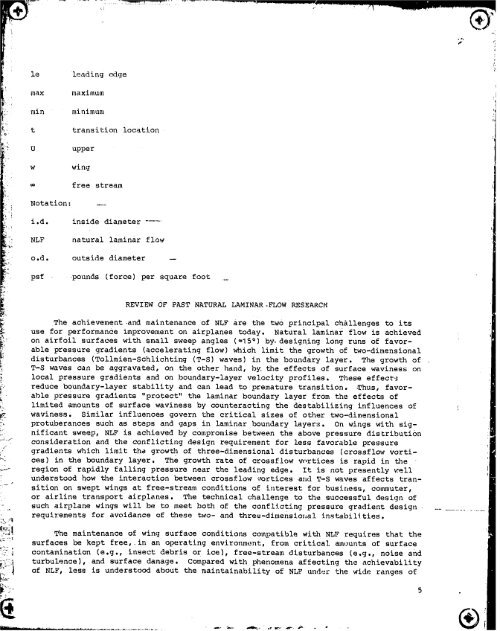NASA Technical Paper 2256 - CAFE Foundation
NASA Technical Paper 2256 - CAFE Foundation
NASA Technical Paper 2256 - CAFE Foundation
You also want an ePaper? Increase the reach of your titles
YUMPU automatically turns print PDFs into web optimized ePapers that Google loves.
max maximum<br />
min minimum<br />
leading edge<br />
t transition location<br />
U upper<br />
w wing<br />
free stream<br />
Notation: --_<br />
i.d. inside diameter ....<br />
NLF natural laminar flow<br />
oed.<br />
psf ,<br />
outside diameter<br />
pounds (force) per Square foot<br />
REVIEW OF PAST NATURAL LAMINAR-FLOW RESEARCH<br />
The achievement and maintenance of NLF are the two principal challenges to its<br />
use for performance improvement on airplanes today. Natural laminar flow is achieved<br />
on airfoil surfaces with small sweep angles (_15 °) by- designing long runs of favor-<br />
able pressure gradients (accelerating flow) which limit the growth of two-dimensional<br />
disturbances (Tollmien-Schlichting (T-S) waves) in the boundary layer. The growth of<br />
T-S waves can be aggravated, on the other hand, b_ the effects of surface waviness on<br />
local pressure gradients and on boundary-layer velocity profiles. These effect_<br />
reduce b0undary-layer stability and can lead to premature transition. _hus, favor-<br />
able pressure gradients "protect" the laminar boundary layer from the effects of<br />
limited amounts of surface waviness by counteracting the destabilizing influences of<br />
waviness. Similar influences govern the critical sizes of other two-dimensional<br />
protuberances such as steps and gaps in laminar boundary layers. On wings with sig-<br />
nificant sweep, NLF is achieved by compromise between the above pressure distribution<br />
consideration and the conflicting design requirement for less favorable pressure<br />
gradients which limit the growth of three-dimensional disturbances (crossflow vorti-<br />
ces) in the boundary layer. The growth rate of crossflow w,rtices is rapid in the<br />
region of rapidly falling pressure near the leading edge. It is not presently well<br />
understood how the interaction between crossflow vortices and T-S waves affects tran-<br />
sition on swept wings at free-stream conditions of interest for business, commuter,<br />
or airline transport airplanes. The technical challenge to the successful design of<br />
such airplane wings will be to meet both of the conflicting pressure gradient design<br />
requirements for avoidance of these two- and three-dimensiozLal instabilities.<br />
The maintenance of wing surface conditions compatible with NLF requires that the<br />
surfaces be kept free, in an operating environment, from critical _ounts of surface<br />
contamination (e.g., insect debris or ice), free-stream disturbances (e.g., noise and<br />
turbulence), and surface damage. Compared with phenomena affecting the achievability<br />
of NLF, less is understood about the maintainability of NLF under the wide ranges of<br />
• ,%<br />
®

















